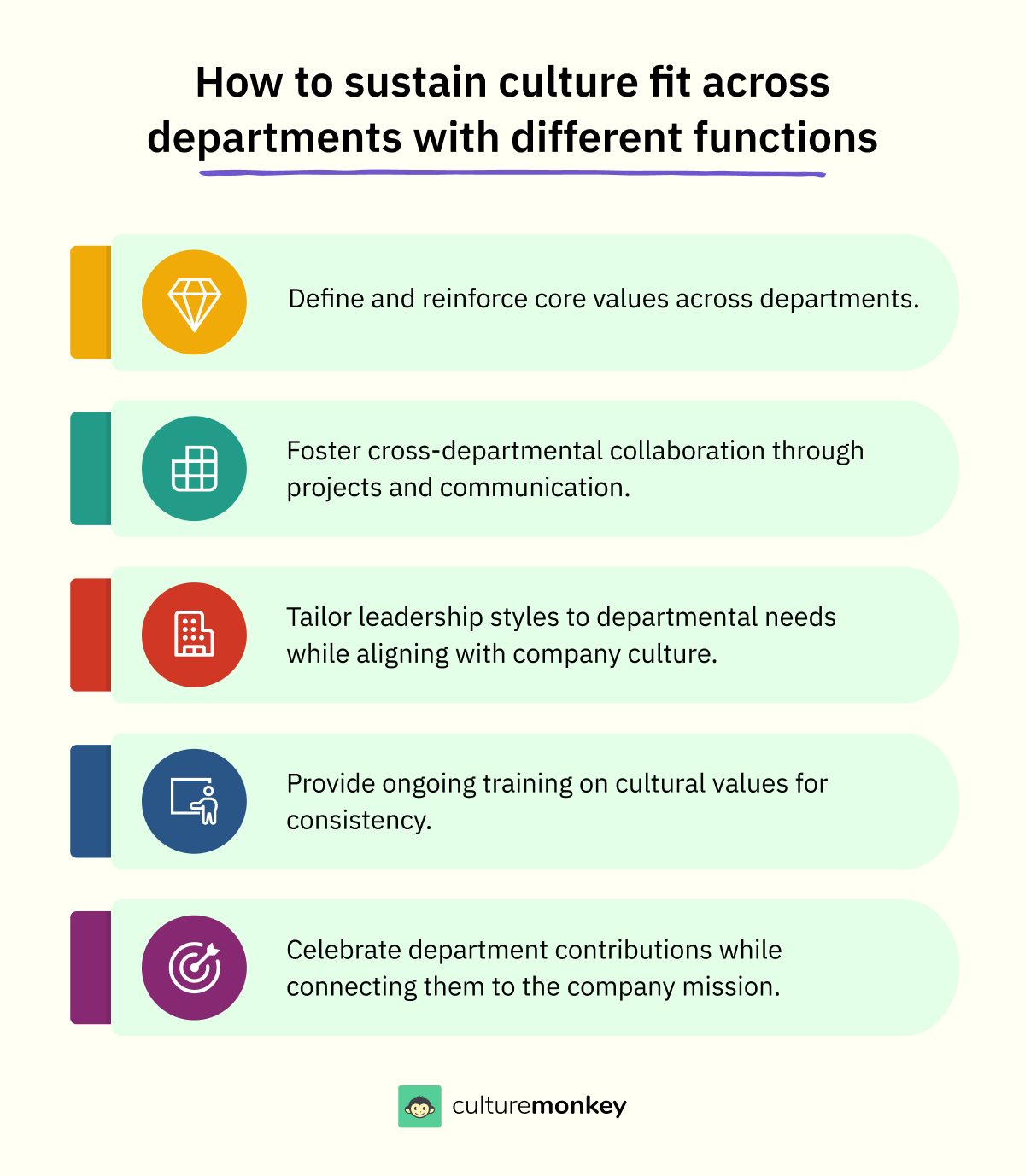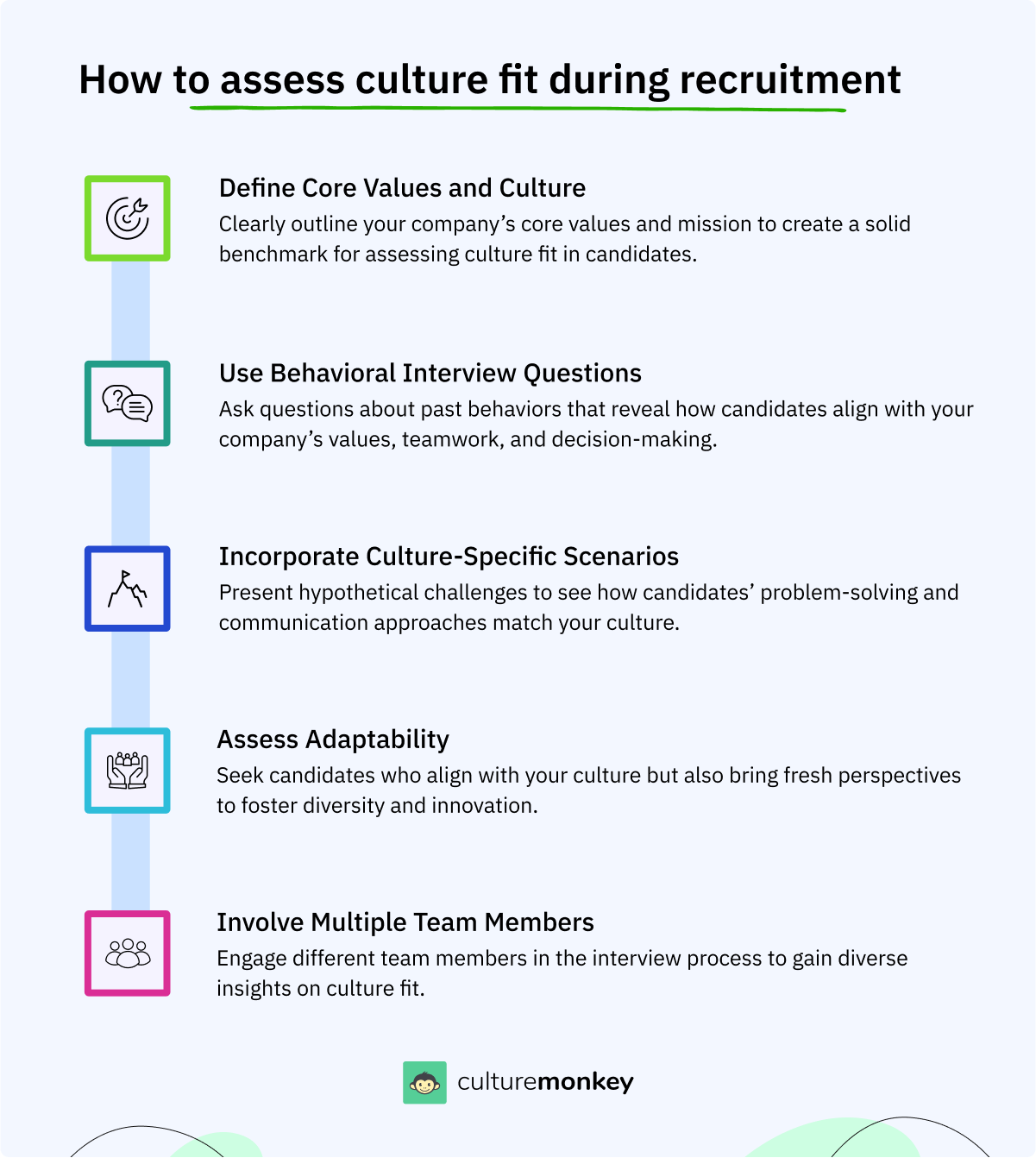What is culture fit: How does it impact your company culture?

Steve Jobs once brilliantly quipped, "The people who are crazy enough to think they can change the world are the ones who do."
And you know what, he's spot on! In the business world, those who dare to dream and innovate often bring about the greatest changes. But if you think finding the employees with the right mentality to align with your organizational purpose is difficult, making them stay is tougher.
So, if you're ready to make your workplace the hotspot of innovation and collaboration, you've come to the right place.
In this blog, we'll explore what culture fit is all about, why it's essential for your business, the benefits it brings, the best strategies, and a lot more. So buckle up, and let's get started.
Blog Highlights


What is company culture?

Company culture is the unique personality and character of your organization. The collective company values, beliefs, behaviors, and customs define how your team interacts and works together. Think of it as the invisible glue that holds your company together.
In fact, company culture directly correlates to revenue. Harvard Business Review reports that organizations with strong corporate cultures see a 4x growth in revenue as opposed to weaker ones.
A strong culture fosters employees' sense of belonging, purpose, and shared mission. It's not just about having a ping-pong table in the breakroom or casual Fridays; it's about the core principles that guide decision-making, communication, and the overall vibe of your workplace.
In essence, company culture sets the stage for how work gets done and your team thrives.
Culture fit meaning
Culture fit refers to how well an employee's values, beliefs, and behaviors align with the company’s culture. When this alignment is strong, it leads to better teamwork as employees collaborate more easily and communicate effectively. It also enhances employee morale, creating a sense of belonging that boosts job satisfaction and engagement.
Employees who fit well with the company culture tend to integrate faster, quickly adapting to workflows and contributing sooner. A strong culture fit helps reinforce the company’s identity, ensuring that everyone works towards shared goals with a consistent approach.
It reduces turnover, as employees who feel aligned with the company’s culture are more likely to be job seekers stay long-term, minimizing recruitment and training costs.
Importance of cultural fit
The importance of cultural fit cannot be overstated, as it plays a critical role in employee satisfaction, performance, and long-term retention.
- Fosters employee well-being: When employees align with the company culture, they experience less stress and burnout. A positive cultural fit leads to a healthier work-life balance, as employees feel more comfortable in their environment and can manage workplace challenges more effectively.
- Promotes adaptability to change: A strong cultural fit enables employees to adapt to organizational changes more smoothly. When employees share the same values, they are more resilient and flexible in navigating shifts in strategy, leadership, or processes.

- Encourages innovation: Cultural fit doesn’t mean uniformity; it means shared values. In an environment where employees feel they belong, they are more likely to take risks, share creative ideas, and collaborate on innovative projects, knowing their input aligns with the company’s mission. This is one of the key factors in project success and organizational growth.
- Builds long-term loyalty: Employees who feel culturally aligned are more invested in the company's success, fostering long-term loyalty. This loyalty leads to stronger relationships, better advocacy for the company, and employees who go above and beyond for the organization.
- Strengthens customer relations: A team that shares cultural alignment can better represent the company's values in customer interactions. This consistency builds trust with customers, as they experience a unified message and approach in every interaction, strengthening relationships and enhancing the brand’s reputation.
The evolution of cultural fit

The evolution of cultural fit has undergone significant transformations in response to changing societal norms, workforce demographics, and organizational dynamics.
Understanding this evolution of cultural impact is essential for organizations seeking to adapt their hiring practices to meet the demands of an increasingly diverse and dynamic workforce. Here's a detailed exploration of the evolution of cultural fit:
Traditional approach
- Historically, cultural fit was narrowly defined as the degree to which a candidate's values, attitudes, and behaviors aligned with those of the existing organizational culture.
- Hiring decisions were often based on subjective assessments and gut feelings, leading to the perpetuation of unconscious bias and homogeneity within the workforce.
Shift towards diversity and inclusion
- As awareness of diversity and inclusion issues grew, organizations began to recognize the limitations of the traditional cultural fit model.
- There was a shift towards embracing diversity and inclusion, with an emphasis on creating a more inclusive workplace where individuals from diverse backgrounds felt valued and respected.
Emphasis on cultural contribution
- The concept of cultural contribution emerged, highlighting the importance of hiring individuals who could bring unique perspectives, experiences, and skills to enrich the organizational culture.
- Organizations started to prioritize candidates who could contribute to the cultural diversity and innovation of the workforce, rather than simply fitting in with the existing culture.
Incorporation of cultural agility
- With the rise of globalization and technological advancements, organizations recognized the need for cultural agility – the ability to adapt and thrive in diverse cultural environments.
- Cultural agility became a sought-after trait in candidates, as organizations sought to navigate increasingly complex and interconnected global markets.
Integration of technology and data analytics
- Advancements in technology and data analytics revolutionized the recruitment process, enabling organizations to assess cultural fit in a more objective and data-driven manner.
- Tools such as predictive analytics, artificial intelligence, and machine learning algorithms were leveraged to identify candidates who not only fit the existing culture but also had the potential to drive cultural evolution and innovation.
Focus on continuous learning and adaptation
- In today's fast-paced and ever-changing business landscape, cultural fit is viewed as a dynamic and evolving concept.
- Organizations prioritize continuous learning and adaptation, recognizing that cultural fit is not static but rather evolves in response to shifting organizational priorities, industry trends, and societal changes.
Difference between culture and engagement
Culture and engagement are two critical concepts in the workplace, but they refer to different aspects of an organization's employee experience. Understanding the distinction between them is essential for creating a successful work environment that fosters both alignment and motivation.
| Aspect | Culture | Engagement |
|---|---|---|
| Definition | The shared values, beliefs, and behaviors that shape the organization’s environment. | The emotional commitment and motivation an employee feels towards their role and the organization. |
| Focus | Collective atmosphere, norms, and work style within the company. | Individual connection and motivation in their specific role. |
| Nature | Long-term concept embedded in the organization’s identity. | Short-term and can fluctuate based on factors like job satisfaction and leadership. |
| Impact | Promotes teamwork, collaboration, and a sense of belonging. | Drives productivity and performance, encouraging employees to go above and beyond. |
What is culture fit bias?

Culture fit bias is when an organization places excessive emphasis on hiring individuals who share a similar background, values, or traits with the existing company culture.
While aligning with the culture is important, this bias can inadvertently lead to discrimination and exclusion of diverse talents. It can limit innovation and hinder the growth of a richer, more inclusive workplace.
Deloitte reports that 68% of employees experiencing bias had a negative impact on their work and productivity.
- Narrowing diversity: Culture fit bias can limit workplace diversity by favoring candidates who resemble the current workforce in terms of background, interests, or personality. This practice can prevent the hiring of individuals who bring new perspectives and ideas, thereby stifling innovation.
- Reinforcing homogeneity: When decisions are based on culture fit bias, it leads to a homogeneous workforce, where everyone thinks and works similarly. While this might create short-term harmony, it restricts creative problem-solving and adaptation to change, as diverse viewpoints are often overlooked.
- Discriminatory hiring practices: Culture fit bias can unintentionally promote discriminatory hiring practices. Candidates from different cultural, ethnic, or socioeconomic backgrounds may be unfairly excluded because they don't conform to the preconceived image of what the "ideal" employee should look like.
- Impact on organizational growth: Bias towards culture fit can hinder long-term growth by blocking the inclusion of talent with fresh ideas and perspectives. Organizations need diversity of thought to remain competitive and evolve with changing market demands.
What are the major culture fit benefits you should know?

Having a great culture fit means your workplace can create a thriving, positive, and high-performing working environment that's not just about getting the job done but about doing it with enthusiasm and purpose. Here are some of the top benefits you will experience.
- Enhanced employee engagement: When employees feel a strong culture fit, they are more engaged in their work. This leads to increased productivity, higher employee satisfaction, and lower turnover rates.
- Improved team collaboration: A cohesive culture encourages better teamwork and communication. When everyone shares common values and goals, it's easier to collaborate effectively and achieve shared objectives.
- Boosted employee retention: Employees who fit well within the culture are more likely to stay with the company long-term. This reduces the cost and increases retention.
- Increased innovation: Culture fit doesn't mean everyone thinks the same; it means they share core values. This diversity of thought within a unified culture can lead to creative problem-solving and innovation.
- Stronger brand and reputation: A positive company culture that resonates with employees and customers can enhance your brand's image, making it more attractive to both potential employees and customers. This can lead to growth and increased profitability.
- Enhanced employee well-being: A strong culture fit contributes to employees' overall well-being by providing a sense of belonging and fulfillment in their roles. This can lead to reduced organizational stress levels and improved mental health, ultimately resulting in higher job satisfaction and performance.
- Greater adaptability and resilience: A culture that embraces flexibility and change enables employees to adapt more easily to shifting circumstances and challenges. This adaptability fosters resilience within the organization, allowing it to navigate uncertainties and thrive in dynamic environments.
9 Culture fit best practices to follow

Here are nine best practices to foster and maintain a healthy culture fit within your organization:
- Clearly define your company culture: Start by articulating your organization's core values, mission, and vision. Make sure all employees understand and embrace these principles as the foundation of your culture.
- Involve employees in culture building: Encourage employee input in shaping the culture. Their insights and perspectives on employee journeys can provide hiring managers with valuable guidance in aligning the culture with the needs and desires of the workforce.
- Prioritize diversity and inclusion: While culture fit is crucial, it also emphasizes diversity. A diverse workforce brings fresh perspectives and ideas to the table. Ensure that your culture is inclusive and welcoming to all.
- Hire for values and soft skills: During the hiring and recruiting process of job candidates, the recruiting team should hire people who share your core values and exhibit soft skills that align with your culture, such as teamwork, adaptability, and communication.
- Onboarding and training: Invest in comprehensive onboarding and continuous training programs for new talent. This ensures that new hires quickly acclimate to the culture, and ongoing learning supports its evolution.
- Regularly assess and adapt: Continuously evaluate your culture fit and be willing to adapt as needed. As your organization grows and changes, so should your culture.
- Recognition and feedback: Acknowledge and celebrate behaviors that align with your culture. Constructive feedback can also help employees understand how their actions impact the overall culture and performance.
- Promote work-life balance: Encourage a healthy work-life balance among employees. Providing flexibility in work hours and offering wellness programs can contribute to a positive culture where employees feel valued and supported in both their professional and personal lives.
- Embrace continuous learning: Encourage a culture of continuous learning and development. Provide opportunities for employees to expand their skills and knowledge through workshops, seminars, and mentorship programs. This fosters personal growth and enhances the overall capabilities of the workforce, contributing to a dynamic and adaptable organizational culture.
How to assess culture fit during recruitment

Here are key ways to assess culture fit during recruitment:
- Define core values and culture: Before assessing culture fit, ensure that your company’s core values, mission, and culture are clearly defined. This provides a concrete foundation against which to measure candidates’ alignment with your organization’s unique culture.
- Use behavioral interview questions: Behavioral interviews are effective for assessing how candidates' past behaviors align with your company’s values. Ask questions that reveal how they handle teamwork, conflict, and decision-making, and whether their actions reflect your cultural expectations.
- Incorporate culture-specific scenarios: Provide candidates with hypothetical scenarios or real challenges your company has faced. Evaluate their responses based on how well they align with your organization’s approach to problem-solving, communication, and collaboration.
- Assess adaptability: Look for candidates who can not only align with the existing culture but also bring unique perspectives. Adaptability is key, as cultural fit shouldn’t stifle diversity or prevent new ideas from thriving.
- Involve multiple team members: Involve different team members in the interview process to get a broader perspective on whether the candidate fits with the company culture. Diverse input ensures a more balanced and holistic assessment.
Is culture fit the same as diversity?
Culture fit and diversity are complementary but different concepts. Culture fit refers to how well an employee’s values align with the company’s core beliefs and work style, while diversity emphasizes the inclusion of individuals from various backgrounds and perspectives.
While culture fit promotes alignment and smooth collaboration, an overemphasis on it can lead to a lack of diversity, limiting creativity and innovation.
Diversity brings fresh ideas and broader viewpoints, driving innovation and problem-solving. Balancing both is essential for success, as culture fit ensures cohesion, and diversity fosters adaptability.
Together, they boost employee retention and engagement, creating a work environment where employees feel aligned with company values while being appreciated for their unique contributions.
The risks of prioritizing culture fit over diversity

Prioritizing culture fit over diversity can lead to several risks that negatively impact organizational growth, creativity, and employee satisfaction. While culture fit is important for cohesion, an overemphasis on it can limit opportunities for diversity, stifling innovation and inclusivity. Here are the key risks of prioritizing culture fit over diversity:
- Lack of diverse perspectives: Over-focusing on culture fit can result in a homogeneous workforce, where similar backgrounds and ideas dominate. This limits the range of perspectives available for problem-solving and decision-making, reducing innovation and creativity.
- Groupthink: A culture that emphasizes sameness can lead to groupthink, where employees are reluctant to challenge ideas or offer different opinions. This stifles constructive debate and can lead to poor decision-making or missed opportunities.
- Exclusion of qualified talent: By prioritizing culture fit, organizations may unintentionally exclude highly qualified candidates who bring diverse skills and experiences simply because they don't "fit" the existing culture. This can narrow the talent pool and overlook valuable contributors.
- Reduced adaptability: Homogeneous teams tend to be less adaptable to change. Diverse teams, on the other hand, bring varied approaches and flexibility, which are critical for innovation and adapting to market shifts.
- Missed opportunities for inclusivity: Emphasizing culture fit may inadvertently create an exclusive work environment, alienating employees from diverse backgrounds and perspectives. This hinders efforts to build a truly inclusive and welcoming workplace.
Culture fit vs culture add vs value fit
Culture fit, culture add, and value fit are distinct yet interconnected concepts that help organizations evaluate how well candidates align with their workplace environment. Understanding the differences between these approaches ensures a well-rounded hiring strategy.
| Aspect | Culture fit | Culture add | Value fit |
|---|---|---|---|
| Definition | How well a candidate aligns with the company’s existing values, behaviors, and work environment. | Candidates who bring unique perspectives, backgrounds, and skills that enhance the culture. | Focuses on aligning a candidate’s core personal values with the company’s foundational values (e.g., integrity, teamwork). |
| Focus | Ensures the individual blends seamlessly into the current culture. | Candidates contribute something new and valuable to the existing culture. | Digs deeper into whether the individual’s beliefs align with the organization’s mission. |
| Risk/Benefit | Overemphasizing can create a homogeneous workforce, limiting diversity and innovation. | Fosters diversity, encourages fresh ideas, and helps avoid groupthink. | Fosters long-term engagement and loyalty by ensuring ethical alignment. |
| Key strength | Ensures smooth collaboration and quicker team integration. | Strengthens innovation and allows the company to evolve with new challenges. | Enhances employee connection to the company’s purpose and long-term goals. |
| Long-term impact | May limit diversity of thought but ensures team cohesion. | Helps the company adapt to new market demands and challenges. | Supports ethical decision-making and alignment with organizational goals. |
Cultural fit examples

Cultural fit is essential for ensuring employees align with a company’s values, mission, and work style. Organizations often use cultural fit as a key criterion in hiring and team building, seeking individuals who complement their existing environment. Here are some examples of cultural fit in practice:
- Google’s team-oriented culture: Google emphasizes collaboration, innovation, and creativity. Candidates who thrive in team-based environments, are open to feedback, and enjoy working on complex problems in a fast-paced setting are considered a cultural fit for Google. Employees are expected to embrace a culture of openness and experimentation.
- Zappos’ customer-first culture: Zappos is known for its focus on exceptional customer service. Their hiring process emphasizes finding candidates who align with their values of empathy, customer satisfaction, and fun. Employees at Zappos are expected to contribute to a culture where customer interactions are positive and personal, fostering strong relationships.
- Netflix’s high-performance culture: Netflix promotes a culture of freedom and responsibility, where high performance is valued, and employees are trusted to make decisions independently. Candidates who thrive in an environment where accountability and self-discipline are key are seen as a cultural fit. Netflix’s culture rewards innovation and encourages employees to challenge conventional thinking.
- Patagonia’s environmentally conscious culture: Patagonia values environmental activism and sustainability. Employees who align with the company's commitment to environmental causes and ethical business practices fit well into the culture. The company seeks individuals passionate about conservation and sustainable living.
What is culture fit assessment?
A culture fit assessment is a structured interview process or set of methods used by organizations to evaluate how well a potential or existing employee aligns with the company's culture. It typically involves various tools and techniques designed to measure an individual's compatibility with the organization's values, behaviors, and work environment. Culture fit assessments may include:
- Interviews: Asking questions that assess a candidate's values, work style, and how they might contribute to the company culture.
- Questionnaires or surveys: Administering written assessments to gauge a person's preferences, beliefs, and compatibility with the organization's culture.
- Role-play or scenario testing: Presenting real-life work scenarios to assess how a candidate or employee would respond and whether their actions align with the company's values.
- Observation: Observing how a person interacts with current employees or engages in group activities to gauge their social and cultural compatibility.
- Cultural fit metrics: Using data analytics to track and measure various cultural fit indicators, such as employee turnover, engagement levels, and performance metrics.

Building Teams That Truly Belong
Guide with 15 culture fit questions to assess candidates' alignment with company values, mission, and team dynamics.
Cultural fit assessment tools
Here are five popular cultural fit assessment tools that help organizations evaluate and maintain a strong cultural alignment:
1. CultureMonkey
- CultureMonkey provides accessible feedback through familiar platforms like WhatsApp, Slack, and Teams, ensuring high participation and real-time insights into employee sentiment.
- The platform offers customizable and multilingual surveys, enabling organizations to gather inclusive and diverse feedback in employees' native languages.
- Supports continuous feedback collection throughout the entire employee lifecycle, allowing organizations to proactively address issues and improve retention.
- With comprehensive insights from over 15 engagement drivers, including work-life balance and leadership effectiveness, it helps organizations gain a deeper understanding of employee engagement.
- The platform ensures GDPR-compliant data security and seamless integration with HRMS platforms, while providing expert support through a dedicated customer success team.
2. Culture Amp
- Offers real-time feedback and engagement surveys to assess cultural alignment.
- Provides analytics to develop strategies for improving employee satisfaction and cultural fit.
3. TINYpulse
- Gathers anonymous pulse surveys to assess team dynamics and cultural fit.
- Offers real-time data to track employee morale and engagement regularly.
4. Officevibe
- Conducts weekly surveys to measure cultural alignment, communication, and leadership impact.
- Tracks employee sentiment to identify cultural gaps and improvement opportunities.
5. Peakon
- Continuously measures engagement and cultural fit through data-driven insights.
- Offers predictive analytics to adapt culture and improve retention based on fit.
Role of leadership in cultural fit

- Setting the cultural tone: Leaders establish the foundation of the organizational culture through their behaviors, decisions, and communication. Their actions reflect the values and expectations that guide employees, making leadership crucial in embedding the desired culture.
- Leading by example: Leaders who consistently demonstrate company values serve as role models, reinforcing cultural fit. When leaders embody the culture, employees are more likely to mirror these behaviors, creating a unified and cohesive work environment.
- Facilitating open communication: Leadership fosters cultural fit by encouraging transparent, two-way communication. Open dialogue allows leaders to understand employees’ perspectives, address any cultural misalignments, and ensure that the organization’s values are clearly communicated and embraced at all levels.
- Supporting employee development: Leaders who prioritize personal and professional growth help employees align with the company culture. By investing in training and development, leadership ensures that employees evolve within the cultural framework, maintaining alignment as the company grows and changes.
- Cultural consistency in decision-making: Leaders influence culture fit by making decisions that reflect core organizational values. Consistent decision-making helps reinforce cultural expectations, making it easier for employees to stay aligned with the company’s mission and goals.
Importance of culture surveys in measuring employee culture fit
Culture surveys play a vital role in measuring employee culture fit by providing insights into how well employees align with an organization’s values, behaviors, and work environment. They offer a structured approach to understanding culture fit and its impact on engagement, performance, and retention.
Here are key reasons why culture surveys are important:
- Assessing organizational alignment: Culture surveys allow organizations to gauge how well employees’ values and behaviors align with the company’s mission and culture. This helps identify gaps between the current workforce and the desired culture, offering a clearer path for improvement.
- Identifying cultural strengths and weaknesses: Surveys provide insights into what employees appreciate about the company’s culture and areas where improvements are needed. This data helps leaders foster a culture that promotes engagement and satisfaction.
- Promoting inclusivity: By gathering feedback from employees, culture surveys help organizations understand whether the existing culture supports diversity and inclusivity. It highlights whether all voices are heard and valued, making it easier to foster a more inclusive environment.
- Tracking cultural evolution: Regularly conducting culture surveys enables companies to track changes in employee sentiment over time. This helps ensure that as the organization grows and evolves, the culture remains aligned with employee expectations and the company’s long-term goals.
- Supporting strategic decisions: Survey data offers actionable insights for making strategic decisions related to hiring, onboarding, and employee engagement. Leaders can use this information to develop initiatives that strengthen culture fit across the organization.
Conclusion
Culture fit is more than a buzzword—it’s a critical component of a thriving workplace. Assessing and nurturing culture fit is essential for building an environment where employees feel aligned with the company’s core values and mission, leading to increased engagement, retention, and overall success.
The insights gained from culture surveys are instrumental in shaping a dynamic and inclusive culture that evolves with the needs of both employees and the organization. By actively listening to feedback, companies can foster a workplace that aligns with organizational goals while inspiring and empowering their teams.
With the support of tools like CultureMonkey’s culture surveys, organizations can continuously refine their culture, ensuring long-term success and a positive employee experience.
Summary
Culture fit is essential for creating a cohesive and motivated workforce. During recruitment, assessing culture fit involves clearly defining core values, using behavioral interview questions, and presenting candidates with culture-specific scenarios.
It helps identify those who align with your company's values and approach. Engaging multiple team members in the process ensures diverse perspectives, while assessing adaptability ensures new hires bring fresh ideas while fitting into the existing culture.
FAQs
1. How can a company maintain a strong culture fit while still accommodating diversity and inclusion?
A company can maintain a strong culture fit while accommodating diversity and inclusion by focusing on shared values and inclusive behaviors rather than superficial similarities. Implementing inclusive hiring practices, providing diversity training, and encouraging diverse perspectives can help cultivate a culture that embraces both alignment with core values and diversity of thought and background.
2. Can culture fit change over time within an organization?
Yes, culture and company fit can change over time within an organization due to various factors such as growth, leadership changes, and market shifts. As the organization evolves, its values, norms, and priorities may also evolve, influencing the cultural dynamics. Additionally, efforts to promote diversity and inclusion, as well as employee feedback and engagement initiatives, can contribute to shifts in culture fit.
3. What role does leadership play in shaping an organization's culture fit?
Leadership plays a pivotal role in shaping an organization's culture fit by setting the tone, modeling behaviors, and defining expectations. Effective leaders articulate the company's values, vision, and mission, guiding employees toward cultural alignment. They prioritize transparency and inclusivity, fostering a culture of trust and collaboration. Through their actions and decisions, leaders influence the organizational climate and sense of belonging among employees.
4. Are there specific industries where culture fit is particularly crucial?
Culture fit is particularly crucial in industries where teamwork, collaboration, and client relationships are paramount, such as hospitality, healthcare, and professional services. Sectors with a strong emphasis on innovation and creativity, like technology and media, often prioritize culture fit to foster a dynamic and cohesive workforce. Culture fit is relevant across all industries as it contributes to employee engagement, retention, and organizational success.
5. How can remote teams ensure culture fit when hiring new employees?
Remote teams can ensure culture fit when hiring by using structured interviews focused on company values, assessing candidates’ alignment with the organization's mission and work style. Tools like virtual culture assessments, personality tests, and trial projects help evaluate how well new hires will integrate into the remote team while maintaining alignment with the company’s core values and communication style.



